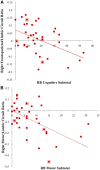Repetitive behaviors in autism are linked to imbalance of corticostriatal connectivity: a functional connectivity MRI study
- PMID: 29177509
- PMCID: PMC5793718
- DOI: 10.1093/scan/nsx129
Repetitive behaviors in autism are linked to imbalance of corticostriatal connectivity: a functional connectivity MRI study
Abstract
The neural underpinnings of repetitive behaviors (RBs) in autism spectrum disorders (ASDs), ranging from cognitive to motor characteristics, remain unknown. We assessed RB symptomatology in 50 ASD and 52 typically developing (TD) children and adolescents (ages 8-17 years), examining intrinsic functional connectivity (iFC) of corticostriatal circuitry, which is important for reward-based learning and integration of emotional, cognitive and motor processing, and considered impaired in ASDs. Connectivity analyses were performed for three functionally distinct striatal seeds (limbic, frontoparietal and motor). Functional connectivity with cortical regions of interest was assessed for corticostriatal circuit connectivity indices and ratios, testing the balance of connectivity between circuits. Results showed corticostriatal overconnectivity of limbic and frontoparietal seeds, but underconnectivity of motor seeds. Correlations with RBs were found for connectivity between the striatal motor seeds and cortical motor clusters from the whole-brain analysis, and for frontoparietal/limbic and motor/limbic connectivity ratios. Division of ASD participants into high (n = 17) and low RB subgroups (n = 19) showed reduced frontoparietal/limbic and motor/limbic circuit ratios for high RB compared to low RB and TD groups in the right hemisphere. Results suggest an association between RBs and an imbalance of corticostriatal iFC in ASD, being increased for limbic, but reduced for frontoparietal and motor circuits.
Keywords: autism spectrum disorder; functional connectivity; repetitive behavior; striatum.
© The Author (2017). Published by Oxford University Press.
Figures




References
-
- Abbott A.E., Nair A., Keown C.L., et al. (2016). Patterns of atypical functional connectivity and behavioral links in autism differ between default, salience, and executive networks. Cerebral Cortex, 26(10), 4034–45.http://dx.doi.org/10.1093/cercor/bhv191 - DOI - PMC - PubMed
-
- Alexander G.E., DeLong M.R., Strick P.L. (1986). Parallel organization of functionally segregated circuits linking basal ganglia and cortex. Annual Review of Neuroscience, 9, 357–81.http://dx.doi.org/10.1146/annurev.ne.09.030186.002041 - DOI - PubMed
-
- American Psychiatric Association. (2000). Diagnostic and Statistical Manual of Mental Disorders-IV-TR. Washington, DC: American Psychiatric Association.
-
- American Psychiatric Association. (2013). Diagnostic and Statistical Manual of Mental Disorders-V. Washington, DC: American Psychiatric Association.
Publication types
MeSH terms
Grants and funding
LinkOut - more resources
Full Text Sources
Other Literature Sources
Medical
Molecular Biology Databases

